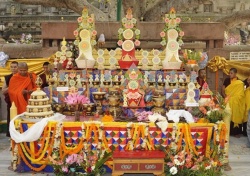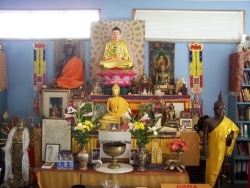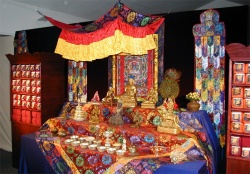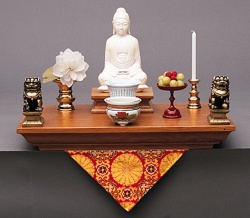Having an Altar at Home
We spend our time thinking of many things but little time thinking of the buddhas and our teachers. Looking after an altar each day with care and devotion ensures that every time we look at it we are reminded of the buddhas. We need to make offerings to the buddhas and
bodhisattvas to receive their blessings; however from their side they have no need of these offerings.
Making offerings helps us to develop spiritual qualities due to the accumulation of method and wisdom. Any act performed with a virtuous motivation brings merit and the more pure the object of our offering is, the greater the merit. This is the
accumulation of method. The accumulation of wisdom means that the offering is performed with the understanding that the one who offers, the act of offering and the objects to whom we are offering are empty of inherent existence.
Objects to be placed on the altar.
• A statue or photo of the Buddha and/or lamas – to represent the body of a buddha
• A dharma text – to represent the speech of a buddha
• A small stupa – to represent the mind of a buddha
• Seven water bowls
• Light and food offerings
The altar can be placed on a table or shelf but should be quite high off the ground as it is disrespectful to have it near the ground. It should not be placed at the foot of the bed as it is disrespectful to stretch one’s legs towards a lama or Buddha image. Traditionally the altar faces east, but this is not essential. The table or shelf can be covered with a cloth that is nice and clean.
The Origin of the Eight Offerings
In ancient India when an important guest was received in the palace of a king, he was first presented with a drink of water. To remove the road dust his feet were washed, and to rest and rejoice his spirit he was offered flowers, incenses and perfume. Lastly he was given a feast
to eat whilst musicians played. In the same way, since the guests we invoke are manifestations of the awakening mind, we make these offerings with humility.
ARGHAM PADHYAM PHUPE DHUPE ALOKE GHANDE NUIDE SHABTA*
Drinking water Washing water Flowers Incense Light Perfume Food Music
(*Light can be a lamp, tea-light or candle—if not then music can be left out to make the seven bowls)
The information on this sheet is intended as a basic guide for people new to Tibetan Buddhism.
Waterbowl offerings at Home
Make three prostrations, then dust the altar and objects on it. The waterbowls are filled each day from a clean jug. They should be offered first thing in the morning, starting from left to right. The bowls themselves should be identical in size and can be made of
silver, copper, crystal, porcelain, glass or any other quality substance. The bowls are then placed in a straight line with the space of a grain of rice (or barley) between them. It is said that too much space between the bowls means that one will be separated from one’s teacher: if too close one becomes attached. Empty bowls on the altar should be placed upside down..
The simplest way to make offering is to fill all the bowls with water. The water should be clean drinking water and can be coloured with saffron.
• Starting from the left, wipe the inside of each bowl with a clean cloth. Then hold the bowl upside down over burning incense saying OM AH HUM (the mantra which represents the blessings of the Buddha’s body, speech and mind). Place each bowl upside down on the altar as they are still empty at this stage.
• Beginning with the left bowl, pour a small amount of water into it. From this bowl pour most of the water into the next leaving a little behind and repeat until they all have some water in them.
• Completely fill each bowl while reciting the mantra OM AH HUM to within the thickness of a grain of rice from the brim. The water should be poured noiselessly and with great respect, as if you are offering a cup of tea to an honoured guest. Both hands should therefore be used to hold the jug.
A more elaborate offering can be made as follows:
• Water: the first two bowls are water for drinking and washing.
• Flowers: in the third bowl either a flower can be placed on white rice or in the water,or plain water can be used while visualising flowers.
• Incense: visualising clouds of incense.
• Light: the fifth offering can be a lamp, tea-light or candle.
• Perfume: the sixth can be perfumed water or plain water visualised as perfume.
• Food: the seventh offering can be a food such as fruit, sweets, chocolate on white rice or just plain water visualised as a banquet.
• Music: can be a conch shell on rice, a small musical instrument or just plain water.
While the bowls are being offered visualise they are being offered to the Buddha’s body, speech and mind.
It is necessary to have a good motivation and although we may be offering water to buddhas and
bodhisattvas, it should be imagined as nectar. Due to pure motivation and making actual offerings properly
and due to the power of the objects one offers to; great virtuous karma is accumulated. At night the bowls are emptied from right to left, dried and left upside down. The water from the bowls should be emptied in a clean place such as the garden or a pot plant. One can visualise giving this nectar to all sentient beings, or one can visualize throwing away all one’s negativities.





